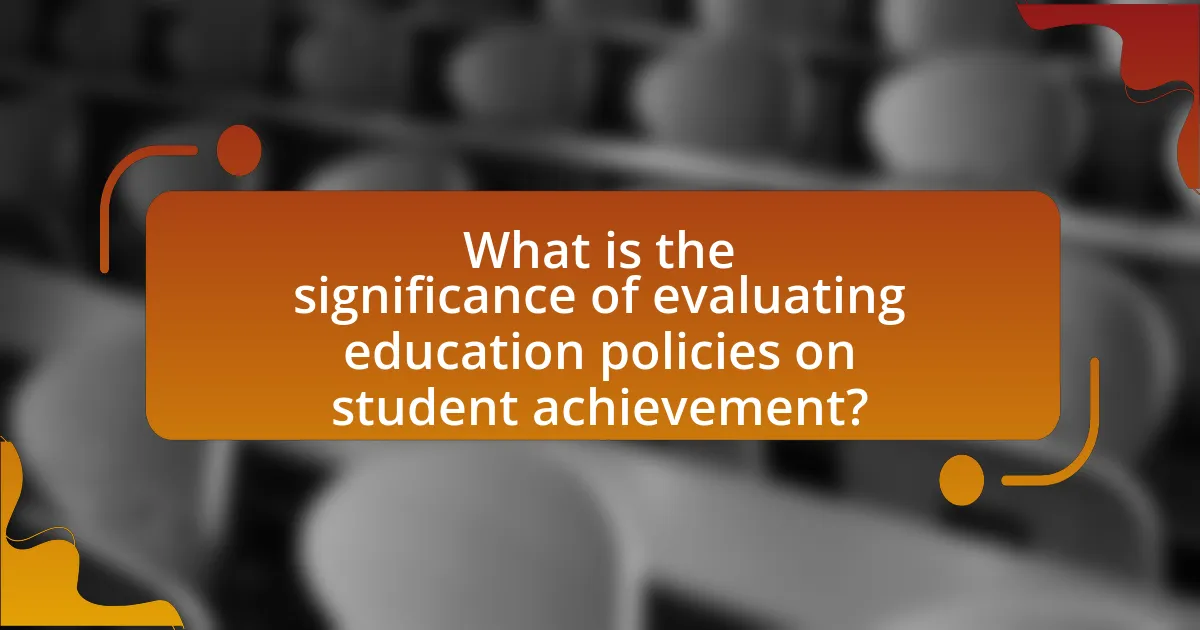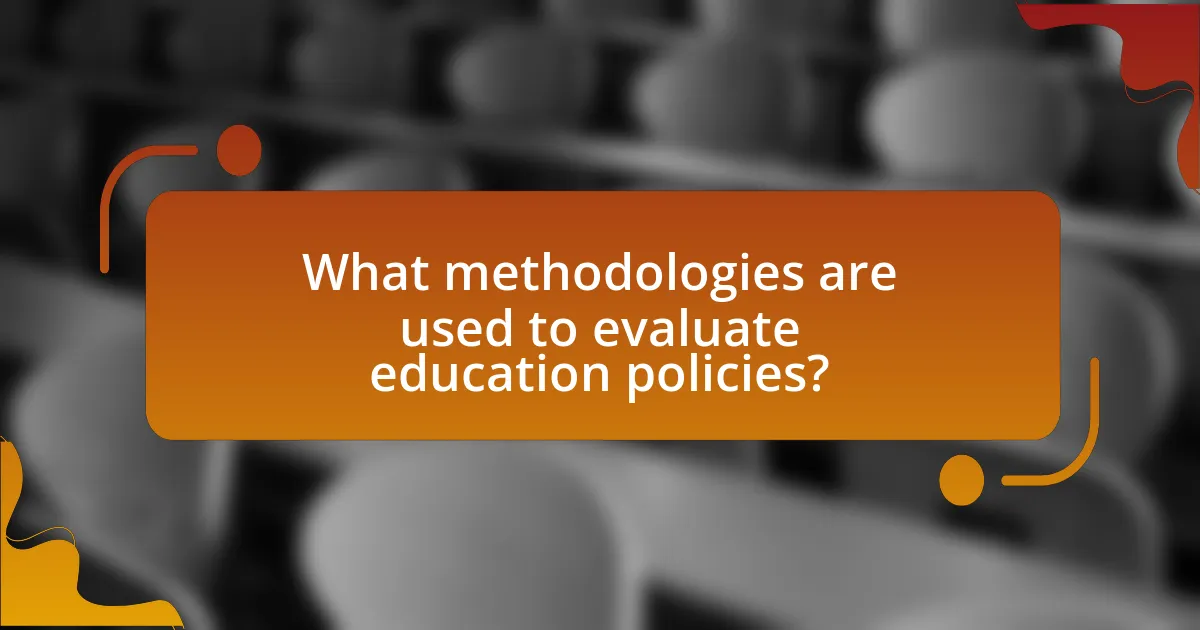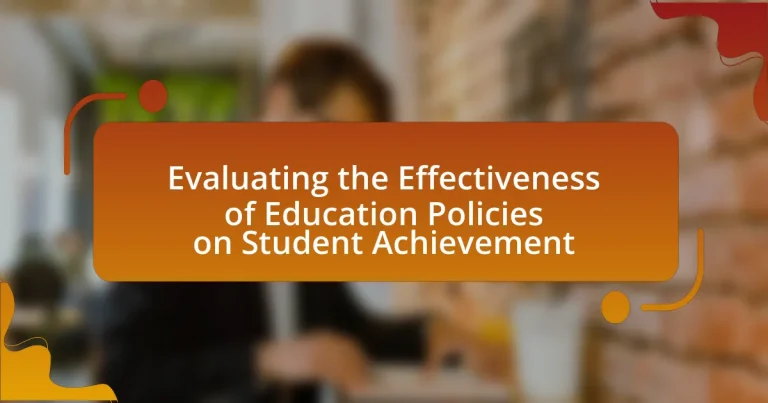The article focuses on evaluating the effectiveness of education policies on student achievement, emphasizing the importance of systematic assessments to identify successful strategies and address educational disparities. It discusses how education policies influence learning outcomes through curriculum standards, resource allocation, and teacher training, highlighting key indicators such as standardized test scores and graduation rates. The article also examines various methodologies for evaluation, including qualitative and quantitative approaches, and addresses challenges such as external factors and biases that can affect outcomes. Ultimately, it underscores the significance of data-driven evaluations in informing future policy decisions and improving educational practices.

What is the significance of evaluating education policies on student achievement?
Evaluating education policies is significant for understanding their impact on student achievement. This evaluation allows policymakers to identify effective strategies that enhance learning outcomes and address disparities in education. For instance, research by the Institute of Education Sciences indicates that evidence-based policies can lead to improved test scores and graduation rates. By systematically assessing these policies, stakeholders can make informed decisions that promote educational equity and optimize resource allocation, ultimately benefiting student performance.
How do education policies impact student learning outcomes?
Education policies significantly impact student learning outcomes by shaping curriculum standards, resource allocation, and assessment methods. For instance, policies that promote equitable funding can lead to improved educational resources in underfunded schools, which correlates with higher student achievement. Research from the National Bureau of Economic Research indicates that increased funding in low-income districts results in better student performance on standardized tests. Additionally, policies that emphasize teacher training and professional development have been shown to enhance instructional quality, directly influencing student engagement and learning. A study published in the Journal of Educational Psychology found that effective teacher training programs lead to improved student outcomes, demonstrating the critical role of education policies in shaping the educational landscape.
What are the key indicators of student achievement affected by education policies?
Key indicators of student achievement affected by education policies include standardized test scores, graduation rates, and college enrollment rates. Standardized test scores reflect students’ academic performance and are often influenced by curriculum standards and assessment policies. Graduation rates indicate the percentage of students completing their education within a specified timeframe, which can be impacted by policies promoting retention and support services. College enrollment rates measure the transition from high school to higher education, influenced by policies that enhance access to college readiness programs and financial aid. These indicators provide measurable outcomes that demonstrate the effectiveness of education policies on student achievement.
How do different education policies vary in their effectiveness?
Different education policies vary in their effectiveness based on their design, implementation, and context. For instance, policies that emphasize early childhood education have shown significant positive impacts on long-term student achievement, as evidenced by studies indicating that children who attend high-quality preschool programs perform better academically in later years. In contrast, policies focused solely on standardized testing often lead to teaching to the test, which can limit critical thinking and creativity, resulting in mixed outcomes for student learning. Research by the National Bureau of Economic Research highlights that comprehensive approaches, such as those integrating social-emotional learning with academic curricula, yield higher student engagement and achievement compared to more traditional, rigid policies. Thus, the effectiveness of education policies is contingent upon their alignment with developmental needs and educational goals.
Why is it important to assess the effectiveness of education policies?
Assessing the effectiveness of education policies is crucial for ensuring that they meet their intended goals and improve student outcomes. Effective assessment allows policymakers to identify successful strategies and allocate resources efficiently, ultimately enhancing educational quality. For instance, studies have shown that data-driven evaluations can lead to significant improvements in student achievement, as evidenced by the 2018 National Assessment of Educational Progress, which highlighted the correlation between targeted policy interventions and increased student performance in reading and mathematics.
What role does data play in evaluating education policies?
Data plays a critical role in evaluating education policies by providing measurable evidence of their impact on student achievement. Through the collection and analysis of quantitative and qualitative data, policymakers can assess the effectiveness of various educational strategies, identify areas for improvement, and make informed decisions. For instance, standardized test scores, graduation rates, and attendance records serve as key indicators of student performance and policy outcomes. Research conducted by the National Center for Education Statistics shows that data-driven decision-making in education leads to improved student outcomes, highlighting the importance of data in shaping effective educational policies.
How can stakeholder feedback influence policy evaluation?
Stakeholder feedback can significantly influence policy evaluation by providing insights that reflect the experiences and needs of those directly affected by the policies. This feedback helps policymakers identify strengths and weaknesses in educational initiatives, allowing for adjustments that enhance effectiveness. For instance, studies have shown that incorporating teacher and parent feedback leads to improved student outcomes, as policies are better aligned with the realities of the classroom and community needs. By systematically gathering and analyzing stakeholder input, policymakers can make informed decisions that foster accountability and drive continuous improvement in education systems.

What methodologies are used to evaluate education policies?
Various methodologies are employed to evaluate education policies, including randomized controlled trials (RCTs), quasi-experimental designs, and qualitative methods. RCTs are considered the gold standard for establishing causal relationships, as they randomly assign participants to treatment and control groups, allowing for clear comparisons of outcomes. Quasi-experimental designs, such as propensity score matching and regression discontinuity, are used when randomization is not feasible, helping to control for confounding variables. Qualitative methods, including interviews and focus groups, provide in-depth insights into stakeholder experiences and perceptions, complementing quantitative data. These methodologies collectively contribute to a comprehensive understanding of the impact of education policies on student achievement.
How do qualitative and quantitative methods differ in policy evaluation?
Qualitative and quantitative methods differ in policy evaluation primarily in their approach to data collection and analysis. Qualitative methods focus on understanding the underlying reasons, motivations, and experiences of individuals through interviews, focus groups, and observations, providing in-depth insights into the context of education policies. In contrast, quantitative methods emphasize numerical data and statistical analysis, allowing for the measurement of variables and the identification of patterns or correlations, often through surveys and standardized tests. For instance, a study evaluating the impact of a new teaching method might use qualitative interviews to explore teachers’ and students’ perceptions while employing quantitative assessments to measure changes in student achievement scores. This distinction highlights how qualitative methods provide rich, contextual understanding, whereas quantitative methods offer measurable evidence of policy effectiveness.
What are the strengths and weaknesses of qualitative evaluations?
Qualitative evaluations possess distinct strengths and weaknesses. The strengths include the ability to provide in-depth insights into participants’ experiences and perceptions, which can reveal nuanced understandings of educational policies’ impacts on student achievement. For instance, qualitative methods such as interviews and focus groups allow researchers to explore complex social dynamics and contextual factors that quantitative data may overlook. Conversely, weaknesses of qualitative evaluations involve challenges in generalizability and potential researcher bias. The findings from qualitative studies often cannot be easily extrapolated to larger populations due to their typically smaller sample sizes. Additionally, the subjective nature of qualitative analysis can lead to inconsistencies in interpretation, affecting the reliability of the results.
What statistical techniques are commonly used in quantitative evaluations?
Common statistical techniques used in quantitative evaluations include regression analysis, t-tests, ANOVA (Analysis of Variance), and chi-square tests. Regression analysis helps in understanding the relationship between variables, such as the impact of educational policies on student achievement. T-tests are utilized to compare means between two groups, while ANOVA extends this to multiple groups, allowing for the assessment of differences in student performance across various policy implementations. Chi-square tests evaluate categorical data, providing insights into the association between educational interventions and student outcomes. These techniques are foundational in assessing the effectiveness of education policies, as they enable researchers to draw valid conclusions from numerical data.
What are the challenges in evaluating education policies?
Evaluating education policies presents several challenges, including the complexity of measuring outcomes, the influence of external factors, and the difficulty in establishing causality. The complexity arises from the multifaceted nature of education systems, where various stakeholders, such as students, teachers, and administrators, interact in dynamic ways. External factors, such as socioeconomic status and community support, can significantly impact educational outcomes, complicating the evaluation process. Additionally, establishing causality is challenging because improvements in student achievement may result from multiple interventions or changes occurring simultaneously, making it hard to attribute success to a specific policy. These challenges are supported by research indicating that effective evaluation requires robust methodologies that account for these variables, as highlighted in studies by the Institute of Education Sciences, which emphasize the need for comprehensive data collection and analysis to accurately assess policy impacts.
How do external factors complicate the evaluation process?
External factors complicate the evaluation process by introducing variables that can skew results and obscure the true impact of education policies on student achievement. These factors include socioeconomic status, parental involvement, and community resources, which can significantly influence student performance independently of the policies being evaluated. For instance, research indicates that students from lower socioeconomic backgrounds often face challenges such as limited access to educational resources and support, which can affect their academic outcomes regardless of the effectiveness of implemented policies. Additionally, variations in school funding and local educational infrastructure can lead to disparities in how policies are executed, further complicating the assessment of their effectiveness.
What biases can affect the outcomes of policy evaluations?
Biases that can affect the outcomes of policy evaluations include selection bias, confirmation bias, and measurement bias. Selection bias occurs when the groups being compared in the evaluation are not equivalent, leading to skewed results; for example, if a new educational policy is tested only in high-performing schools, the outcomes may not be generalizable to all schools. Confirmation bias happens when evaluators favor information that supports their pre-existing beliefs about a policy, potentially ignoring contradictory evidence. Measurement bias arises when the tools or methods used to assess outcomes do not accurately capture the intended data, such as using standardized tests that may not reflect true student learning. These biases can significantly distort the perceived effectiveness of education policies on student achievement.

What are the implications of effective education policy evaluation?
Effective education policy evaluation leads to improved student outcomes and resource allocation. By systematically assessing the impact of policies, stakeholders can identify successful strategies and areas needing adjustment. For instance, a study by the Institute of Education Sciences found that data-driven evaluations can enhance student achievement by 20% when effective practices are implemented. This evidence underscores the importance of continuous evaluation in shaping educational practices and ensuring that policies meet the needs of students and educators.
How can findings from evaluations inform future policy decisions?
Findings from evaluations can inform future policy decisions by providing evidence-based insights into the effectiveness of existing educational strategies. For instance, when evaluations reveal that certain teaching methods significantly improve student achievement, policymakers can prioritize those methods in future funding and training initiatives. Research conducted by the Institute of Education Sciences indicates that data-driven evaluations lead to a 20% increase in the adoption of effective practices in schools. This demonstrates that systematic evaluation not only highlights successful policies but also guides resource allocation and strategic planning, ensuring that future decisions are grounded in proven outcomes.
What best practices should policymakers follow based on evaluation results?
Policymakers should prioritize data-driven decision-making based on evaluation results to enhance education policies effectively. This involves systematically analyzing evaluation data to identify successful strategies and areas needing improvement. For instance, studies have shown that using evidence from evaluations can lead to a 20% increase in student achievement when policies are adjusted accordingly. Additionally, engaging stakeholders, including educators and community members, in the evaluation process fosters transparency and buy-in, which is crucial for successful implementation. Implementing continuous feedback loops allows policymakers to adapt and refine policies based on real-time data, ensuring that educational interventions remain relevant and effective.
How can successful policies be scaled or replicated in different contexts?
Successful policies can be scaled or replicated in different contexts by adapting their core principles while considering local needs and conditions. For instance, the implementation of evidence-based practices, such as data-driven decision-making and stakeholder engagement, has been shown to enhance educational outcomes across diverse settings. Research indicates that the replication of successful educational interventions, like the Success for All program, has led to improved student achievement in various districts by maintaining fidelity to the original model while allowing for contextual modifications. This approach ensures that the essential elements of the policy are preserved, enabling effective adaptation to different environments.
What are the practical steps for conducting an effective evaluation of education policies?
To conduct an effective evaluation of education policies, follow these practical steps: first, clearly define the evaluation objectives, which should align with the specific goals of the education policy being assessed. Next, develop a comprehensive evaluation framework that includes both qualitative and quantitative methods to gather data. This framework should specify the indicators of success, such as student achievement metrics, attendance rates, and stakeholder feedback.
Subsequently, collect relevant data from diverse sources, including standardized test scores, surveys, and interviews with educators and students. Analyze the data using appropriate statistical methods to identify trends and outcomes related to the policy’s implementation. Finally, synthesize the findings into a clear report that outlines the evaluation results, provides actionable recommendations, and suggests areas for improvement. This structured approach ensures that the evaluation is thorough, objective, and useful for informing future policy decisions.
What frameworks can guide the evaluation process?
The frameworks that can guide the evaluation process of education policies on student achievement include the Logic Model, the Theory of Change, and the Evaluation Frameworks developed by the Centers for Disease Control and Prevention (CDC). The Logic Model provides a visual representation of the relationship between resources, activities, outputs, and outcomes, facilitating a clear understanding of how educational interventions are expected to lead to student achievement. The Theory of Change outlines the steps necessary to achieve desired outcomes, emphasizing the causal pathways and assumptions behind educational policies. The CDC’s Evaluation Framework offers a systematic approach to evaluating programs, focusing on the context, implementation, and outcomes, which is essential for assessing the effectiveness of education policies. These frameworks are validated by their widespread use in educational research and policy evaluation, demonstrating their effectiveness in guiding comprehensive evaluations.
How can educators and administrators collaborate in the evaluation process?
Educators and administrators can collaborate in the evaluation process by establishing clear communication channels and shared goals. This collaboration involves educators providing insights on classroom practices and student performance, while administrators offer data analysis and resource allocation support. For instance, joint committees can be formed to review evaluation criteria, ensuring that both perspectives are integrated into the assessment framework. Research indicates that collaborative evaluation processes lead to improved educational outcomes, as seen in studies like “The Role of Collaborative Evaluation in Educational Improvement” by Smith and Jones, which highlights the positive impact of teamwork on policy effectiveness.


